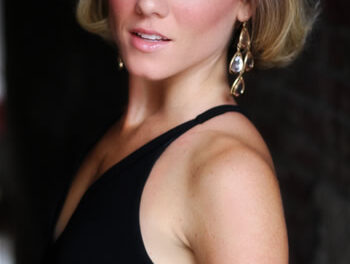All things being relative, Martha Connerton/Kinetic Works brought an interesting transformation to Actor’s Theatre of Charlotte just by staging a dance event there. Aside from Children’s Theatre of Charlotte, Actor’s is the professional group with the highest standing in town, with the largest performing space of its own. Moving from the theatre sphere to Charlotte’s dance scene, I’m accustomed to seeing local companies at Belk Theater, Ovens Auditorium, Halton Theater, Booth Playhouse, and the new Knight Theater. Next to those, ambiance at Actor’s Theatre seemed raw and funky. The stage suddenly looked small, even though the production values of the KinetiCollective’s Working With program permitted choreographers to expand the floor and work with the area that usually serves as the backstage. Aside from Connerton, who contributed her Las Hermanas del Corazon (A Movement Study), the potpourri included Sent. Received. by Jessica Stewart, Inside this painted mind by Arlynn Zachary, “Come Dawn” by Bridget Morris, and Press Play by Camerin Watson. All of these choreographers were exploring the possible relationship between dance, other art forms, and technology.
Starting off with a focus on a letter writer, Sent. Received appeared to be considering the evolution of communication devices in recent times and the deterioration of actual human communication that has come with that evolution. Dancers began folding their letters into paper planes, some more flight-worthy than others, and launching them before a second episode began with swivel chairs and corded phones. The tangling of those cords was the first sign that advancing technology was actually, to some extent, an impediment to communication. It became clearer in the concluding episode, when all five dancers came back with cell phones, never making physical contact or eye contact with each other – until one of the five dancers dropped her phone. Amid this catastrophe, the little community briefly became aware of one another.
Although Stewart’s messages were not particularly original, I found her piece more engaging than Zachary’s, which the program notes indicated was the springing forth of clay, metal, and water from a painter’s concept on paper into live moving figures. I probably would have failed a test on which of the three dancers was which. I’ll recuse myself on the images that Corina Brown was working on at her easel, except to observe that projects of this sort work best when the visual artist begins from scratch with the capacity to paint quickly enough to complete a piece within the timespan of the performance. In this instance, Zachary gave Brown close to 18 minutes to astonish us, but the painter worked so laboriously with such a thin brush that the canvas did not look dramatically changed when she came center stage to share in the closing bows.
Morris based “Come Dawn” on the Tom Dula (Dooley) murder of Laura Foster in 1866 that subsequently became transformed into the folksong that catapulted the Kingston Trio to the top of the charts in 1958. The dancing choreographer poignantly portrayed the poor victim, but the choreography for the two men didn’t sufficiently characterize them, so it wasn’t until I researched the history and the legend that I was able to positively differentiate Grayson, danced by Javier Gonzalez, from the man who was so famously hanged. Obviously, more drama might have been felt in this 18-minute “excerpt from a larger work” if more focus had been placed on the murderer and his motives. My best guess on who was seen with the banjo in the role of Tom is Craig Bove, who is credited as the composer.
The listing of the choreographer alone – “Martha Connerton with a contact improvisation computer program invented by Bill Young, in collaboration with the dancers” – was nearly enough by itself to make Los Hermanas the most interesting piece of the evening. But it was the charming execution by Emily Morgan and Kim Diepold that put the distance between their duets, to traditional songs from Brazil and Mexico, and everything else we saw. At random, the computer had generated contact points between the two dancers, so that Morgan’s foot might have to touch Diepold’s chest at one moment and Diepold’s elbow might have to contact Morgan’s back the next. Somehow, Diepold and Morgan always kept the two conflicting elements of this concept balanced, the random robotic computer element and the fun-filled party element you may know from the familiar Twister game.
After these “Sisters of the Heart” departed, Watson’s Press Play was an anticlimax, less personable and less purposeful. Conceived as “a study on the impact of environment on individual expression,” it was unclear how that impact was playing out. Perhaps in the first segments, the environment was represented by dancers dressed in black, while the individual was represented by the single performer with a color in her costume. Fair enough, for the dancer in the standout costume tended toward the center of the cluster, but there was no evidence of any environmental impact happening before our eyes or in the development of the choreography. Nor were the individuals, mostly the same group that had performed the opening Sent. Received., among the best soloists we had seen during the evening. Four or five of the seven women, the soloists who had worn the colors, returned for the final segment, a promising touch. But what these individuals had become – or what those varying colors signified – remained a riddle.
Despite numerous blips during the evening, KinetiCollective delivered the excitement of variety and experimentation. Performers and choreographers at different levels of proficiency were all trying to push the envelope. In the process, they presented intriguing challenges for their audience while pushing each other toward greater excellence.











